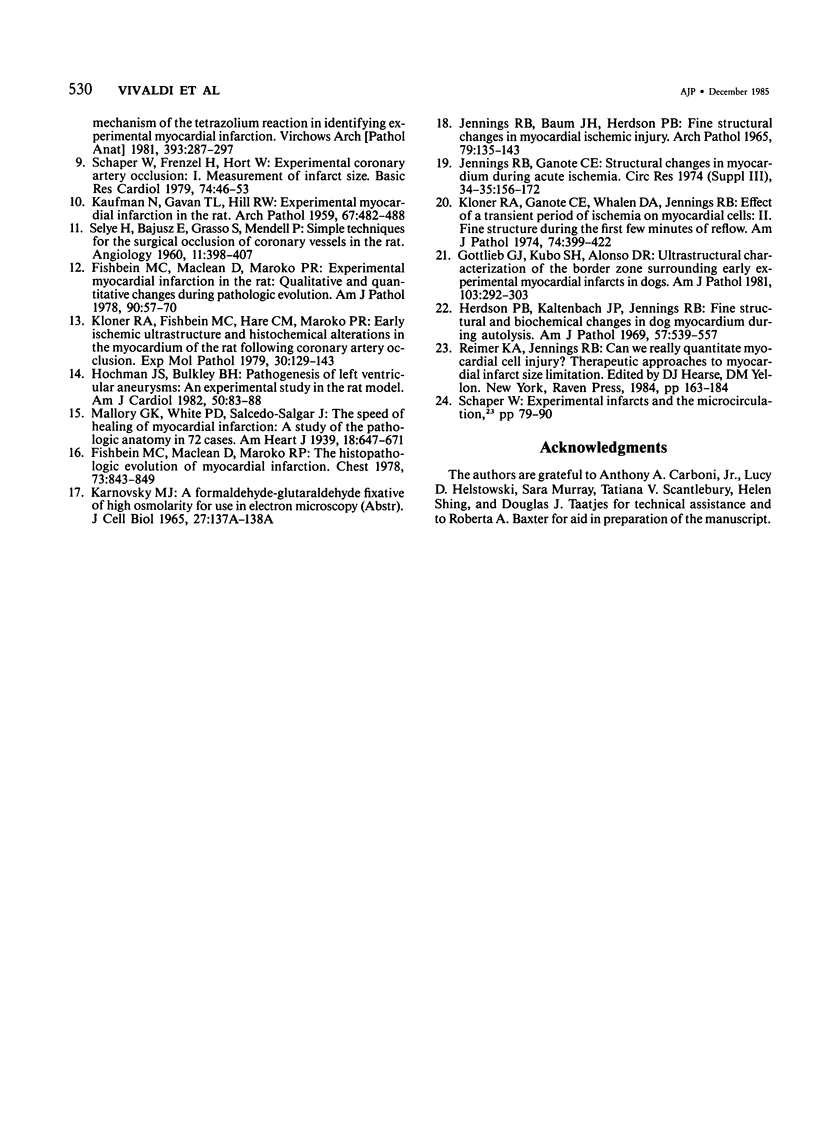Abstract
The objectives of this study of triphenyltetrazolium chloride (TTC) gross histochemical staining of myocardial infarcts were to determine the accuracy of sizing of established infarcts, to determine the time course of development of staining defects during infarct evolution, and to determine the effect of clinically relevant autolysis on the detectability of early infarcts. Transverse sections of excised rat hearts after left coronary artery occlusion were incubated in TTC for 5 minutes at 37 C. After 48 hours, planimetrically determined infarct size (percent left ventricle [LV%]) by TTC and by conventional histologic study (H) correlated well: TTC (LV%) = 1.04 X H(LV%) - 2.94 (r = 0.98; P less than 0.001). Ischemic zone staining defects, detected in 50% of hearts 30 minutes after occlusion, were noted in all hearts occluded 3 hours or longer. Gross staining contrast was not diminished by in situ autolysis for 6 hours at ambient temperature or for 24 or 72 hours at 4 C. In conclusion, TTC reliably permits quantitation of the size of completed infarcts. TTC often detects ischemic injury as early as 30 minutes after coronary occlusion in the rat and in all hearts by 3-6 hours. Infarct demarcation by TTC is preserved during simulated clinical autolysis.
Full text
PDF








Images in this article
Selected References
These references are in PubMed. This may not be the complete list of references from this article.
- Derias N. W., Adams C. W. Nitroblue tetrazolium test: early gross detection of human myocardial infarcts. Br J Exp Pathol. 1978 Jun;59(3):254–258. [PMC free article] [PubMed] [Google Scholar]
- Fishbein M. C., Maclean D., Maroko P. R. Experimental myocardial infarction in the rat: qualitative and quantitative changes during pathologic evolution. Am J Pathol. 1978 Jan;90(1):57–70. [PMC free article] [PubMed] [Google Scholar]
- Fishbein M. C., Maclean D., Maroko P. R. The histopathologic evolution of myocardial infarction. Chest. 1978 Jun;73(6):843–849. doi: 10.1378/chest.73.6.843. [DOI] [PubMed] [Google Scholar]
- Fishbein M. C., Meerbaum S., Rit J., Lando U., Kanmatsuse K., Mercier J. C., Corday E., Ganz W. Early phase acute myocardial infarct size quantification: validation of the triphenyl tetrazolium chloride tissue enzyme staining technique. Am Heart J. 1981 May;101(5):593–600. doi: 10.1016/0002-8703(81)90226-x. [DOI] [PubMed] [Google Scholar]
- Gottlieb G. J., Kubo S. H., Alonso D. R. Ultrastructural characterization of the border zone surrounding early experimental myocardial infarcts in dogs. Am J Pathol. 1981 May;103(2):292–303. [PMC free article] [PubMed] [Google Scholar]
- Herdson P. B., Kaltenbach J. P., Jennings R. B. Fine structural and biochemical changes in dog myocardium during autolysis. Am J Pathol. 1969 Dec;57(3):539–557. [PMC free article] [PubMed] [Google Scholar]
- Hochman J. S., Bulkley B. H. Pathogenesis of left ventricular aneurysms: an experimental study in the rat model. Am J Cardiol. 1982 Jul;50(1):83–88. doi: 10.1016/0002-9149(82)90012-1. [DOI] [PubMed] [Google Scholar]
- JENNINGS R. B., BAUM J. H., HERDSON P. B. FINE STRUCTURAL CHANGES IN MYOCARDIAL ISCHEMIC INJURY. Arch Pathol. 1965 Feb;79:135–143. [PubMed] [Google Scholar]
- Jennings R. B., Ganote C. E. Structural changes in myocardium during acute ischemia. Circ Res. 1974 Sep;35 (Suppl 3):156–172. [PubMed] [Google Scholar]
- KAUFMAN N., GAVAN T. L., HILL R. W. Experimental myocardial infarction in the rat. AMA Arch Pathol. 1959 May;67(5):482–488. [PubMed] [Google Scholar]
- Kloner R. A., Fishbein M. C., Hare C. M., Maroko P. R. Early ischemic ultrastructural and histochemical alterations in the myocardium of the rat following coronary artery occlusion. Exp Mol Pathol. 1979 Apr;30(2):129–143. doi: 10.1016/0014-4800(79)90050-9. [DOI] [PubMed] [Google Scholar]
- Kloner R. A., Ganote C. E., Whalen D. A., Jr, Jennings R. B. Effect of a transient period of ischemia on myocardial cells. II. Fine structure during the first few minutes of reflow. Am J Pathol. 1974 Mar;74(3):399–422. [PMC free article] [PubMed] [Google Scholar]
- Lie J. T., Pairolero P. C., Holley K. E., Titus J. L. Macroscopic enzyme-mapping verification of large, homogeneous, experimental myocardial infarcts of predictable size and location in dogs. J Thorac Cardiovasc Surg. 1975 Apr;69(4):599–605. [PubMed] [Google Scholar]
- Ramkissoon R. A. Macroscopic identification of early myocardial infarction by dehydrogenase alterations. J Clin Pathol. 1966 Sep;19(5):479–481. doi: 10.1136/jcp.19.5.479. [DOI] [PMC free article] [PubMed] [Google Scholar]
- SELYE H., BAJUSZ E., GRASSO S., MENDELL P. Simple techniques for the surgical occlusion of coronary vessels in the rat. Angiology. 1960 Oct;11:398–407. doi: 10.1177/000331976001100505. [DOI] [PubMed] [Google Scholar]
- Schaper W., Frenzel H., Hort W. Experimental coronary artery occlusion. I. Measurement of infarct size. Basic Res Cardiol. 1979 Jan-Feb;74(1):46–53. doi: 10.1007/BF01907684. [DOI] [PubMed] [Google Scholar]





